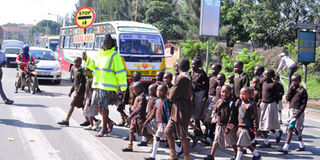Why road safety around schools should be enhanced

Pupils cross a road. PHOTO
What you need to know:
Child road safety has not been a priority, yet very simple measures can be taken to safeguard our children.
It is important for motorists to slow down when near schools.
As much as is possible, children should be accompanied and supervised as they cross roads.
A Bill on road safety for children, which has been in Parliament since 2014, was finally passed recently. All this time, there were debates as to whether we should safeguard our children or not.
On June 14, children from St. Anne’s Primary School blocked Jogoo Road in Nairobi in protest after matatus hit a pupil and a traffic marshal on two different days.
It was sad to see the children, who should have been in class learning, taking action in the best way they knew how. But we must ask ourselves: where were the adults that needed to protect the children? This very conspicuous and widely reported incident is not unique to Jogoo Road.
It is reported that between 300 and 400 children lose their lives on their way to and from school through accidents every year. Most of them are unaccompanied. All that these children want is a chance to acquire an education, which is a basic right.
Most of these incidents do not get media coverage. Parents and guardians are forced to dig deep into their pockets to cater for medical bills and sometimes funeral costs. The children who survive sometimes end up with lifelong complications, including disability.
PSYCHOLOGICAL CHALLENGES
According to the National Transport and Safety Authority, by June 1, this year, 1,276 Kenyans had lost their lives. Among these are children who mostly walk to and from school.
Children have physiological challenges that are often ignored. They have a limited attention span and can easily be distracted. They are also prone to making poor judgments, especially regarding speed and distance. Sometimes children require to cross multiple lanes in places where there are no safety features. As part of daily routine, children, therefore, expose themselves to imminent danger as they transverse these roads in their quest for an education.
For the children who have to use school transportation, this has been highly unregulated. We have been treated to scenes where a bus with a capacity to carry 30 children has more than double that number of pupils. School bus drivers do not have special training to be able to handle children while on the buses. The buses are also not fitted with safety features that children can use.
Why are we in this situation? Child road safety has not been a priority, yet very simple measures can be taken to safeguard our children.
SLOW DOWN
First, it is important for motorists to slow down when near schools. As much as is possible, children should be accompanied and supervised as they cross roads. I salute the crossing guards who risk their lives every day as they help children cross roads.
A Bill on road safety for children, which has been in Parliament since 2014, was finally passed recently. All this time, there were debates as to whether we should safeguard our children or not. You may ask, does the Bill guarantee child safety? It at least gives a legal framework within which safety around schools can be enhanced.
I hope that as Kenyans we can begin to be sensitive when driving around schools to avoid the unnecessary deaths and injuries we expose our children to. The Jogoo Road incident did not have to happen. If we take action, our children won’t have to risk their lives defending themselves!
Bright Oywaya is the chairman, Road Safety Alliance-Kenya.





